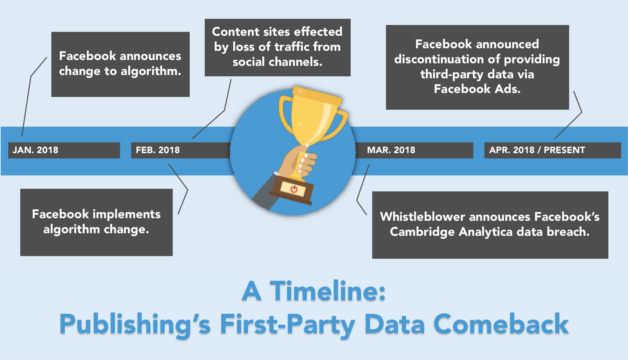
Facebook’s prominent presence in national news during Q1 of 2018 has involved stories about changes impacting publishers and media companies in multiple ways, both good and bad. ONEcount recapped the effects of the changes the social media network made and reviewed what this all means for digital publishers.
January 2018:
For the past few years publishing, and media organizations became reliant on Facebook to distribute content and attract users to content websites. This practice helped increase website traffic from social channels when audiences would engage with the content.
Content site publishers became worried after Facebook’s announcement of a change to their algorithm going into effect next month. The change would involve prioritization of content in Facebook’s news feed from friends and family, rather than organization’s pages.
Also, leading up to this time, organizations of all types increased marketing efforts involving content marketing. According to an article in MarketingLand, content marketing job listings on Indeed grew 350% between 2011 and 2015.
Facebook’s advertising platform was used to target and re-target users using first-party data, like visitors to websites or user interests shared with Facebook. As well, organizations had the ability to hyper-target sponsored content using third-party data layered-in by data aggregators—from providers like Acxiom and Experian.
Both of these capabilities Facebook offered were used to serve relevant content to audiences matching certain characteristics. These marketing strategies became popular methods to build and develop audiences.
February 2018:
Facebook’s algorithm change went in to effect at the beginning of February 2018. This resulted in publishers and media companies seeing drops in web traffic from social channels.
Most publishers had, in some way, adapted their business models to monetize content websites using Facebook’s news feed as it had been an effective way to gain web traffic.
Media companies with content sites who were reliant on this model struggled. A few content sites, like Little Things, closed their doors. Specifically, this content site’s “…organic traffic (the highest margin business), and influencer traffic were cut by over 75%,” said Joe Speiser, CEO of LittleThings in a memo issued to company employees. “No previous algorithm update ever came close to this level of decimation.”
March 2018:
Most recently, Facebook’s advertising business has come under fire as a result of mishandled customer data obtained by Cambridge Analytica from a Facebook application called “My Digital Life”. Users and friends of users who accessed the application had their personal data from Facebook profiles captured, stored and sold.
Looking to improve security, Facebook announced it will stop allowing advertisers to use third-party data aggregators to hyper-target ads served via their network.
The Present:
Publishers have regained a competitive advantage to compete in digital advertising markets.
The relationships publishers have created with their readers contains a myriad of first-party data, such as: CRM data, account records from fulfillment vendors, digital newsletter subscription statistics from e-mail service provider’s (ESP’s), website and advertising analytic(s), demographics, and purchase history¬¬—to name a few.
Using a customer data platform (CDP), like ONEcount, publishers consolidate customer data from various data silos into one single platform and can activate valuable data to target campaigns based on advertiser needs.
ONEcount not only allows publishers to create rich advertising segments by combining first-party data but also has integrations with third-party data onboarding technologies like LiveRamp (an Acxiom company). These integrations, all included out-of-the-box, allow publishers of any size to compete with large ad networks, like Google.
For example, a local newspaper’s advertiser is an online streaming video service for children. The advertiser wants to reach families with children who watch movies at home.
Using ONEcount, the publisher can create a segment consisting of data from the publisher’s survey response database for respondents that indicated “Yes, have children” on a recent survey and/or those who subscribe to the “Family Events” weekly e-newsletter. To increase the ad’s effectiveness, third-party data can be used to define the segment from integrated technologies—like LiveRamp. This allows the publisher to also hyper-target families who have a history of purchasing or renting movies.
Activating first-party data to deliver relevant content to audiences is essentially “low-hanging fruit” publishers can take advantage of. Combining that data with third-party data gives publishing companies a great advantage to boost the value of advertising products.
About ONEcount
ONEcount is the only identity-driven advertising and targeting data management platform. To learn more about how you can optimize your existing audience to create rich targeting segments for advertisers, contact Joanne Persico by e-mail at joanne@one-count.com, or call 203-665-6211 ext. 204.

